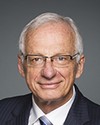Good afternoon. Thank you for affording me the opportunity to discuss some of the things we're doing within the Department of Veterans Affairs.
It's been a couple of years since I testified before all of you. I've been up there a couple of times, but usually when I come up, it's January and February, so it's a little colder.
I'm happy to talk about the Department of Veterans Affairs and some of the new initiatives we are doing. First, I'll put it in context so that everybody understands the organizational structure of the Department of Veterans Affairs.
We are the second largest cabinet in the government, the first being the Department of Defense. VA has three administrations under it. It has our benefits side, which I reside in, our health side, and our cemeteries and memorials side.
Our health side has what is probably the largest hospital network facilities in the world. We have over 1,700 facilities, from big brick-and-mortar facilities all the way to what we call community-based outpatient clinics, along with what we're doing more and more of, which is telehealth benefits. We serve nearly nine million veterans in the health care arena.
Our cemeteries and memorials side would be our smaller administration. We oversee cemeteries for about 4.3 million veterans and their family members who reside on our grounds. We inter about 130,000 a year within our memorial affairs side.
On the benefits side, which is what I fall under, we have seven business lines within DVA. Our biggest one would be disability compensation. In our disability compensation, we provide monetary benefits to just over 4.6 million veterans who are in receipt of disability compensation. Our pension and fiduciary program, which is a program for our wartime veterans, is a smaller program, as it's a means-based one, based on your income. That has about 500,000 veterans.
Our vocational rehabilitation and employment program is a benefit program for those veterans who are service connected for disability compensation but who might need further education. That's actually how I got my undergrad degree. It was through vocational rehab, not our education program. For voc rehab, we have about 135,000 veterans who participate in that program as well. It's really to help those with service-connected disabilities to get back to the daily act of living.
I'm sure you've heard about our education program. It's mostly our Post-9/11 GI Bill. We've given that benefit out to 1.74 million, so it's getting close to two million. That would be not only veterans; this benefit allows you to transfer that entitlement to your spouse or dependant as well.
In our home loan benefit, this past year we did over 705,000 guaranteed loans. It's a great benefit that can be used numerous times throughout your life once you're eligible. One of the keys to that benefit is that, as you know, we've been working hard to end homelessness, and part of doing this in the VA home loan program is that if we become aware you're becoming delinquent on a home payment or are in financial problems, whether you have a home loan with VA or not, we will work on your behalf, the veteran's behalf, with the lending institution to try to keep you in that home.
For example, last year we helped 97,000 veterans stay in their homes, without going to foreclosure, to keep them from becoming homeless. This is a huge benefit, because once you lose your home, typically where do you go next? It's a great program within our home loan benefit.
Another part of that is what we call our specially adapted housing benefit. That is for severely disabled veterans who need a benefit to adapt their home to make it wheelchair accessible or whatever that may be. We did almost 2,000 applications last year in the specially adapted housing program.
We have over six million who are covered under our insurance. Our insurance has a huge coverage, with about $1.2 trillion in coverage for those who have opted for our insurance program.
Our benefits assistance service, our last program, is really our outreach. It's the three phases: I can do face-to-face communicating of benefits; I can do it online—and for many of the systems, we're moving toward self-service capabilities—and I can do it over the phone.
Last year we did a huge initiative. We answered about 20 million phone calls last year, but one of the big problems we had was the blocked call rate. We had a 59% blocked call rate. Veterans couldn't get in. To get an answer to the call, there was a hold of five or 10 minutes or even longer. We reduced that to 25 seconds and a 0% blocked call rate. Really, a lot of that is attributed to driving more services online. That's what we're seeing with today's veterans. They want to do things online. They want it fast and quick. We still need to do some work, though, to get into the mobile app arena, which is what we're looking at as well, but that initiative was huge for us.
There are a couple of other big initiatives.
You might have heard the President and our secretary announce today our electronic health records initiative. We do most everything with DOD in partnership. Today's announcement was a historic one, in that we had worked together to do interoperability with information and data exchange. DOD did a long assessment over a couple of years to determine what application and architecture platform they wanted. They made that decision while VA was still wondering where it was going to go. Today, the secretary and the President announced that we will be going with the same platform and the same software as DOD. That is a huge win-win for service members and veterans, because we will use the same software and the same electronic health record from the moment the service member comes in, all the way through their life cycle, until they use their last benefit, which is memorial affairs.
We have worked on making some huge strides in VBA and VA as a whole. On the benefit side, I know that the last time I testified to you, it was around our backlog. We were really taking a lot on that.... We had a peak inventory of 611,000 claims. That number is down, with the backlog being just under 100,000, at about 95,000 or so. We've made great strides there.
Also, we've automated the process to go completely paperless. We have another initiative now for all of our paper record folders that were in our regional offices. In VBA, we have 56 regional offices, including two in Manila and Puerto Rico. They had paper folders there. We have an initiative now whereby we're taking out the paper folders and sending them to our scan vendor, who is digitizing them and putting them into our application, or what we call the veterans benefits management system, which is what we use to process disability claims.
We've also created a centralized intake claims processing piece, to the point where we no longer accept mail. We learned this from you on our trips up there in terms of how you had centralized your processes. Now, all the mail we receive goes to our intake site, where it is digitized and scanned, and then it becomes electronic for our use. We're looking at doing more OCR technology to pull the data, because you can do a lot more with data than you can with paper.
I've talked about another couple of concepts before, including e-benefits, the joint VA-DOD portal, where we're capturing service members as soon as they enlist and staying engaged with them throughout their life cycle, helping them until they get ready to separate. Also, we had legislation passed in 2011 that now makes it mandatory for all separating service members to attend a separation briefing. We call it the transition assistance program, but it's not just with VA and DOD; it includes the Department of Labor, the Social Security Administration, the Office of Personnel Management, and the Department of Education. It includes our other cabinet organizations, which are all working together to help that service member transition into the civilian sector. We're seeing a lot of benefits from that program.
We still have some work to do. The secretary is really concerned about our suicide prevention efforts. There are too many suicides.



